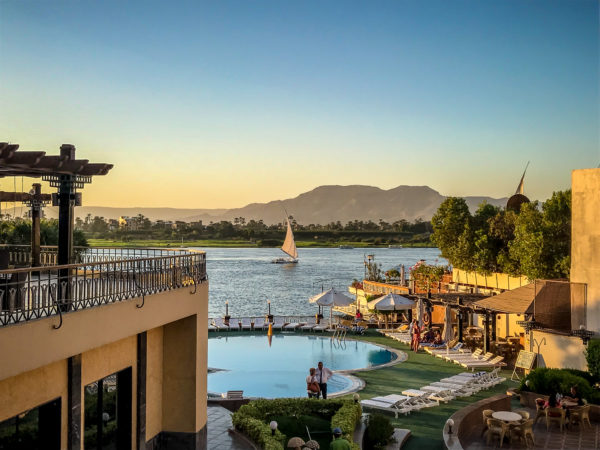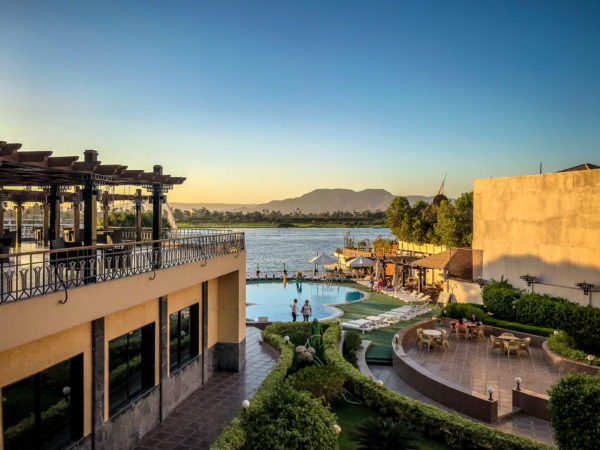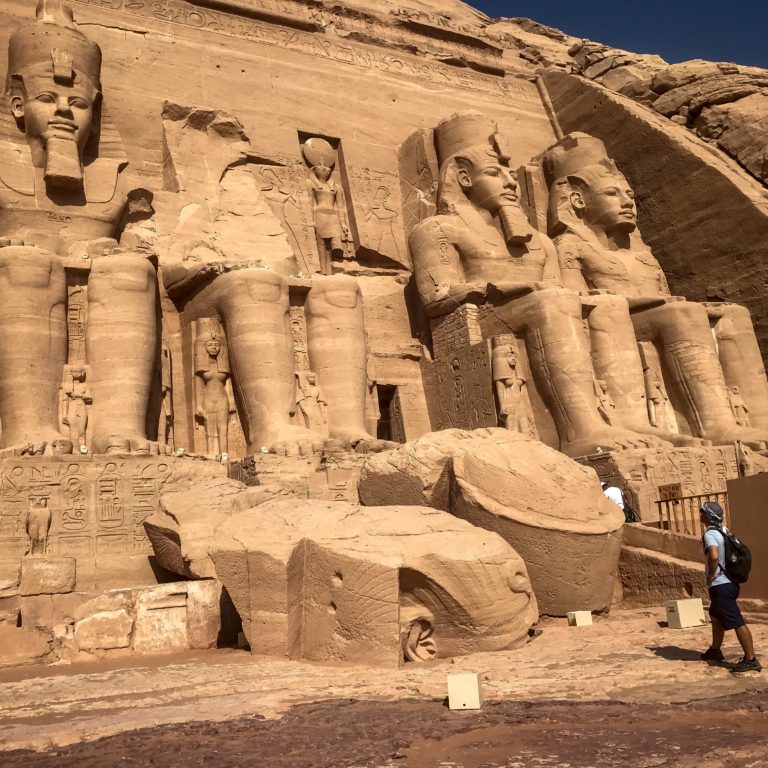Last updated on 01 May, 2019 at 12:45 am
What would have been ancient Egypt without its source of life, the Nile? In any case not this civilization having created impressive temples and majestic pyramids, resistant to the time and to the different occupations of the country by the foreign powers having ruled there over the centuries.
After visiting Cairo for three days, we went to visit the center and the south of Egypt by cruising on the Nile from Aswan to Luxor. We have of course visited the various archaeological remains present on the road, such as the temple of Abu Simbel, the Valley of the Kings or the temple of Hatshepsut. The cruise lasted three days. We then went to Hurghada to rest for a few days on the shores of the Red Sea.
To have all the details about our tour (price, exact planning), read our article on Egypt. Coming soon.
Journey from Cairo to the boat in Aswan
To begin our adventure, we took a night train to Aswan, starting point of our Nile cruise. The train was leaving early in the evening from Cairo. The journey takes about 12 hours, rather 13 in our case. We had a two-berth compartment with dinner and breakfast the next day served in our compartment. The person in charge of the car even came to prepare our beds, not that we are lazy but you need a special key to tilt the berths.
There are two direct ways to get to Aswan from Cairo, either by train or by plane. Until recently, it was apparently cheaper to travel by plane than by train, but this trend changed lately.
Upon arrival in Aswan, our guide was waiting for us on the tracks and brought us to our room on the boat.
Visit of Aswan Dam
In the afternoon, we went to visit Aswan. On the menu: first, the two dams of Aswan on the Nile, where the new one became famous as, due to its construction, many ancient temples risked to be flooded and needed to be relocated, and then the temple of Philae, one of the temple thas was relocated.
Aswan Dams
We started by visiting the old dam and then the high dam. If the height is not impressive compared to what is common in Switzerland, the length of the dam is quite impressive. The wall of the high dam is indeed 3’800 meters long!
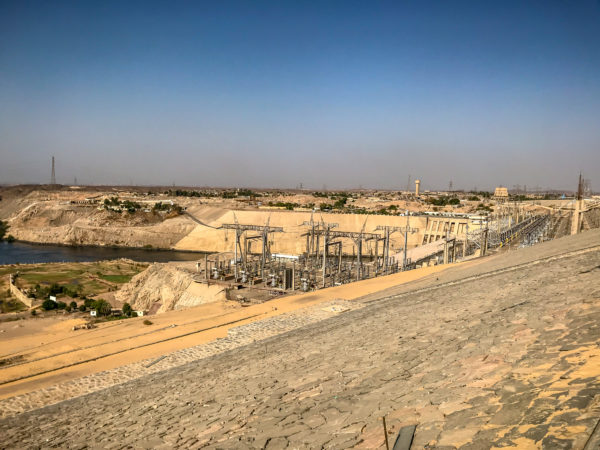
The size of the lake has left us speechless. Beginning in Aswan, it was still present in Abu Simbel, yet 300 kilometers to the south, and even to neighboring Sudan.
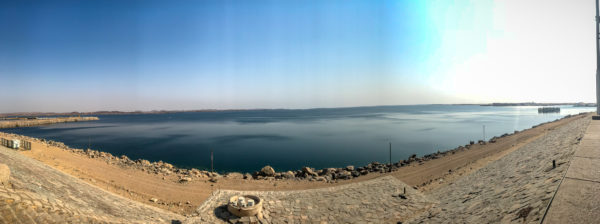
Another important element is the strong police presence and the systematic control of cars that want to use the dam. When we understand that this dam has a strategic importance and the threat is different than the one home, we better understand the need for these checkpoints.
The Philae Temple, moved from its original location in 1960 by UNESCO
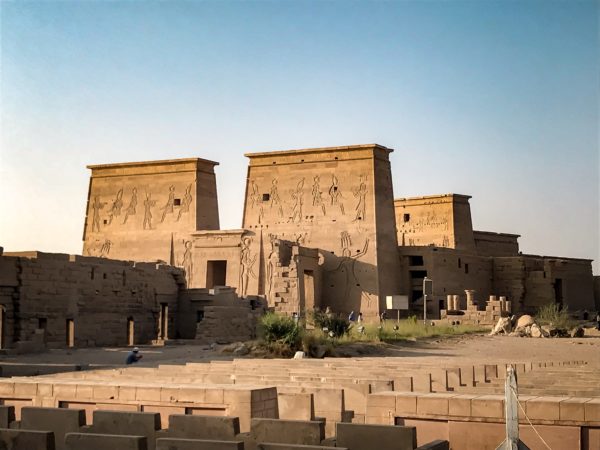
A temple built by the Greeks for the Egyptians, the Philae Temple was moved from its original location by UNESCO in the 1960s during the construction of the High Dam as well as several other temples. Today, only the top of its original location is still visible.

Dedicated to the goddess Isis, the temple is surrounded by water and can only be reached by boat. The temple was built when Egypt was under Greek rule. Thus, it has a Greek architecture. In order to go in the direction of the Egyptians, hieroglyphs were added on the walls to represent the Egyptian mythology.

The island has also several other additional temples and chapels added during the course of history.
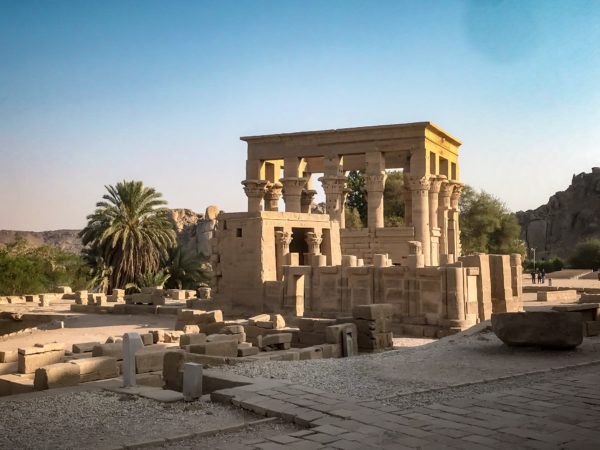
The best time to take pictures of the temple is the end of the afternoon when the sun will illuminate the gigantic gateway to the temple.
Visit of Abu Simbel temple early in the morning
This temple, built by Pharaoh Ramses II, is also part of the temples that were moved after the construction of the Aswan High Dam. The relocation of this temple made by UNESCO in the sixties was even more complex. Indeed, Abu Simbel’s temple is dug into the rock! Thus, it was necessary not only to make blocks with the different statues but also to excavate them from the surrounding mountain, to move them before rebuilding them at the new site with, as if this was not enough, the rise of the water of the dam as a stressful factor. An artificial, sand-covered dome currently surrounds the temple ensuring the stability of the underlying rock. Moreover, beside the temple, an exhibition displays in texts and photographs the epic story of the relocation.
After a (very short) night on the boat at the pier, we went to visit this Abu Simbel temple.
And you don't arrive at Abu Simbel whenever you want.
Indeed, for security reasons, there are convoys leaving at given times several times a day, the first being at 5 o’clock in the morning. It was ours, and as the departure of the convoy was 30 minutes from our boat, we left at 4:15. Waking up was difficult that day.
We took a minibus with other tourists. As we were the last to climb, we sat in the first rows of the vehicle, so I was less likely to be sick, having a good view of the road.
What a mistake. A terrible mistake.
Two tourists (probably Mexican) sitting just behind us had decided that 4:30 am was no longer an hour to sleep but rather to talk, tell his life and laugh in a Hispano-English mix. Goodbye the idea of having a second night during the 3 hours of travel… they didn’t stop a single second of the whole trip…
Once arrived, we visit the site with the explanations of our guide.
As our driver drove quite fast all along, the horde of tourists didn’t arrived yet and we enjoy the calm to take beautiful pictures, the sun is also ideally placed at this time of day.
When we leave the site at 9:30, the situation will be very different, many groups are present and it’s therefore difficult to take pictures without tourists.
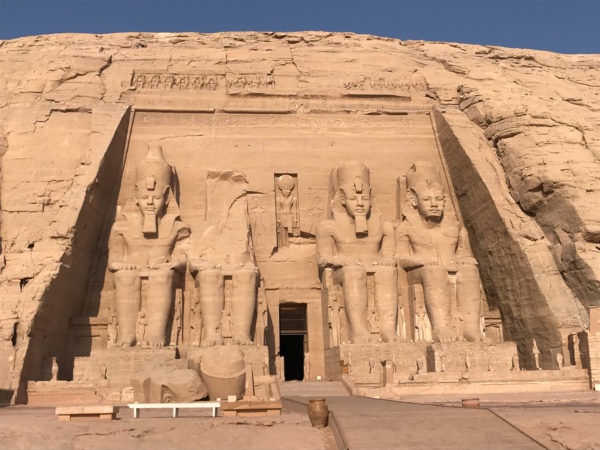
The main door with the statues of Ramses II standing in front of itself are worth the trip. The size of the statues imposes respect. Everything is done to the glory of Ramses II. So much so that the temple was built so that twice a year light enters the temple and directly illuminates the statue of Ramses II as well as those of two other gods. There is also a statue alley representing him when entering the temple.
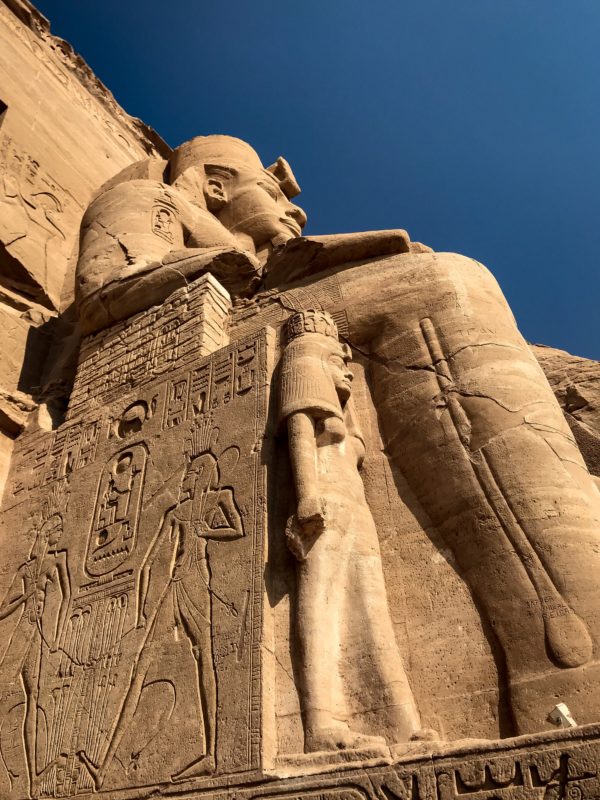
Besides, the temple of Nefertari, his wife
The adjacent temple dedicated to the main woman of Ramses II, Nefertari, is just as beautiful although less impressive. The statues do not exceed the knees of the statues of Ramses II (easy to imagine the size of the ego of the Pharaoh).
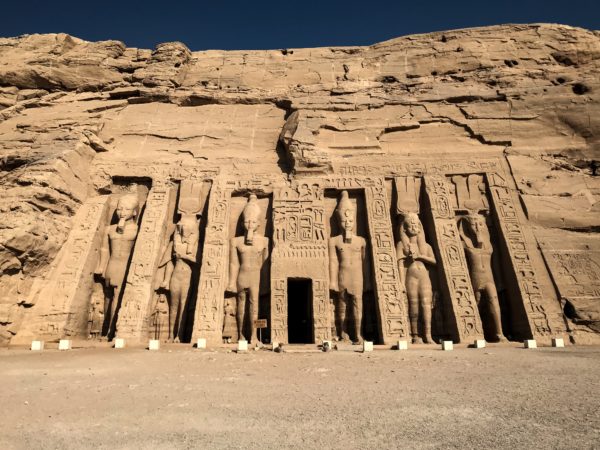
The temple of Kom Ombo in the evening
Once back on the boat, we sail to the temple of Kom Ombo, another Greek temple located on the side of the Nile. This temple has the specificity of being dedicated to two gods, the god of crocodiles Sobek and Horus. Thus everything is split, halls, shrines and courtyards and the temple has an axis of symmetry between the parts dedicated to each of the gods.
We visit this temple in the evening. Well placed lighting gives an extra dimension to the visit.

The only downside of our visit is a guide who doesn’t know his subject well enough to satisfy our curiosity. His explanations were short and limited to the description of what we saw without perspective or analysis of the representation. While beside us, we heard guides in French or German giving this kind of details that we crave for. It was also at that moment that we realized that we came back from Abu Simbel without knowing who Ramses II really was while the temple was dedicated to him…

This guide should have accompanied us for the next visit but after explaining him what we didn’t like, we contacted our tour organizer who changed the guide for the next day without discussion. A posteriori, I think we should have specified our desires at booking time already.

The nearby crocodile museum exhibits some of the three hundred crocodile mummies found on the site. It should be noted that the god of crocodiles were personified (or animated) in a real crocodile who had the chance to live in the temple and to be fed generously without effort.
Edfu temple
After sailing a good part of the night, we arrived the next morning at Edfu and went to visit the temple with our new guide.

This one satisfies our curiosity and draws parallels between the representations of the scenes with the daily life of ancient or current time. It’s with such kind of explanations that we can leave the reductive vision that we often have of ancient Egypt and that we can only note that their level of reflection on life was quite advanced and almost equivalent to what we’re currently experiencing.

Other temple built by the Greeks for the Egyptians, the Edfu temple is dedicated to Horus, here represented by a falcon.
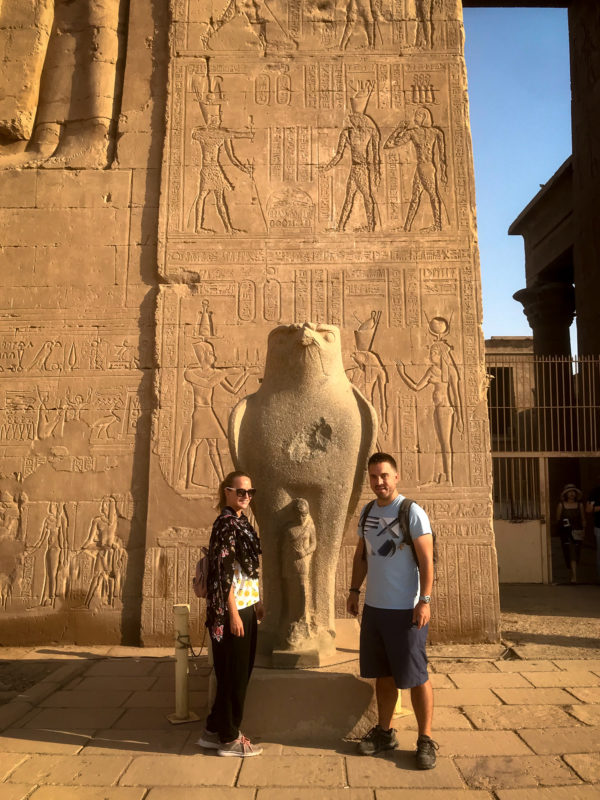
The program of the rest of the day is farniente on the boat, which sails to Luxor, the final destination of our Nile cruise where we arrived at the end of the day after passing the Esna lock. It’s quite impressive to see the operation of a lock with boats of this size.
Visits of Luxor surroundings
After a last night on the boat at the pier in Luxor, the guide came to pick us up and we went to visit the monuments on the left bank of the Nile, the colossi of Memnon, the temple of the Queen of Hatshepsut and the Valley of the Kings, unfortunately we didn’t go to the Valley of the Queens.
Memnon Colossi
The colossi of Memnon are the only remains of the temple of Amenhotep. The temple had the height of the two colossi and expanded for five hundred meters. Many excavations take place on the location of the temple, it can’t be visited.
According to me, if you’re limited by the time, it’s a monument that you can leave out of your visit.

The best time to take pictures of the colossi is in the morning, the photographer will have the sun behind him.
Hatshepsut temple or Deir el-Bahari
Queen Hatshepsut wanted to rule and, struggling to be accepted, created the story that she was the daughter of her mother and the god Amon. She also built a temple carved in stone by her lover architect and, such that its temple is unique in its kind, she killed the same lover architect. The end justifies the means said one guy…
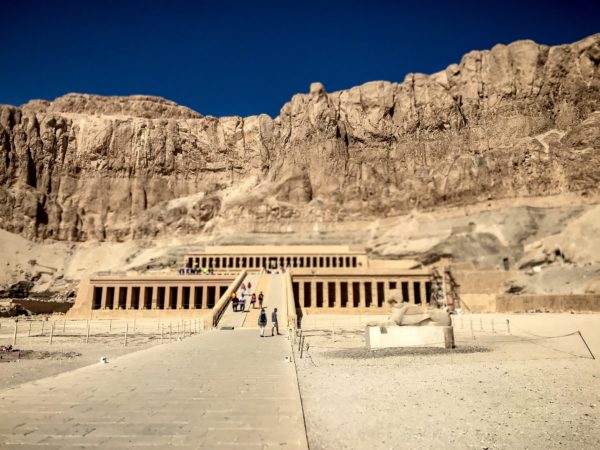
Since she had removed the young legitimate heir from the throne to rule in his place, at her death, the real heir had all the Atchepsut representations destroyed in the temple as revenge. The temple is largely renovated. Composed of three terraces, its size is quite impressive.
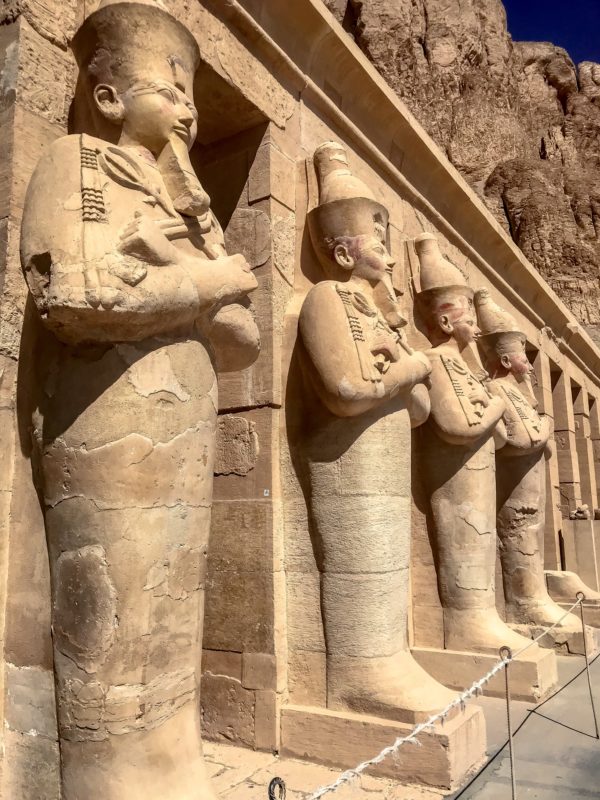
It’s best seen in the morning with the sun in the back of the photographer.
Valley of the Kings
The pyramids although magnificent, are very visible and easy to find for looters that want to seize the wealth of the pharaohs. Therefore, they had the idea to bury their graves in the mountain (pyramid-shaped, they are clever nontheless) in order to escape looters. The workers were not allowed to return home as long as the construction of the tomb was not finished.
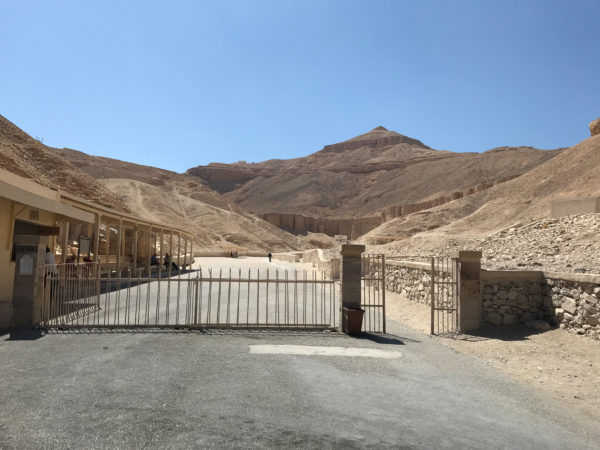
It has only worked moderately well since most, though not all, tombs have been looted over the centuries. This is where the intact tomb of Tutankhamun was found at the beginning of the twentieth century, buried under the sand. Egyptians dream of having such a chance again: there would still be many pharaohs for which we ignore the location of their grave.
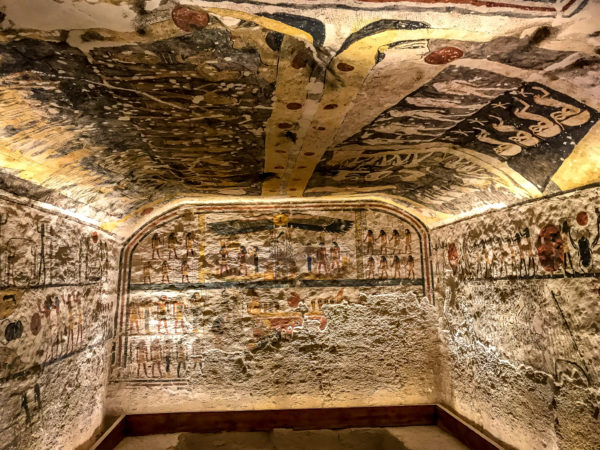
The entrance ticket gives you access to three tombs. Some tombs have to be bought in addition such the one of Tutankhamun as well as others with an ticket price as high as their excellent state of conservation. We decided to settle for the three graves.
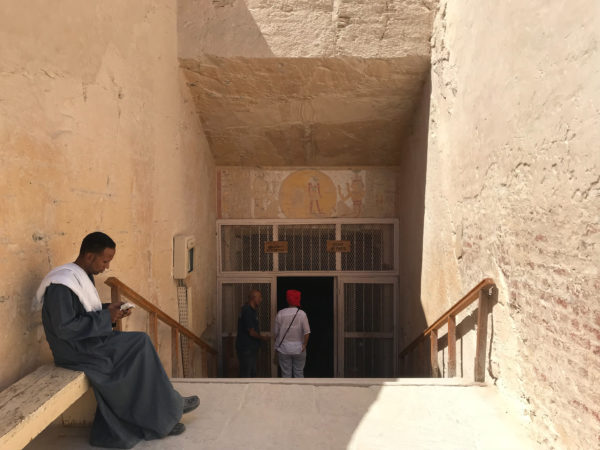
All the graves have a quite similar design. A long corridor connects the entrance to the sarcophagus. The walls represent the usual scenes of Egyptian mythology. The hieroglyphs are in more or less good state of conservation.
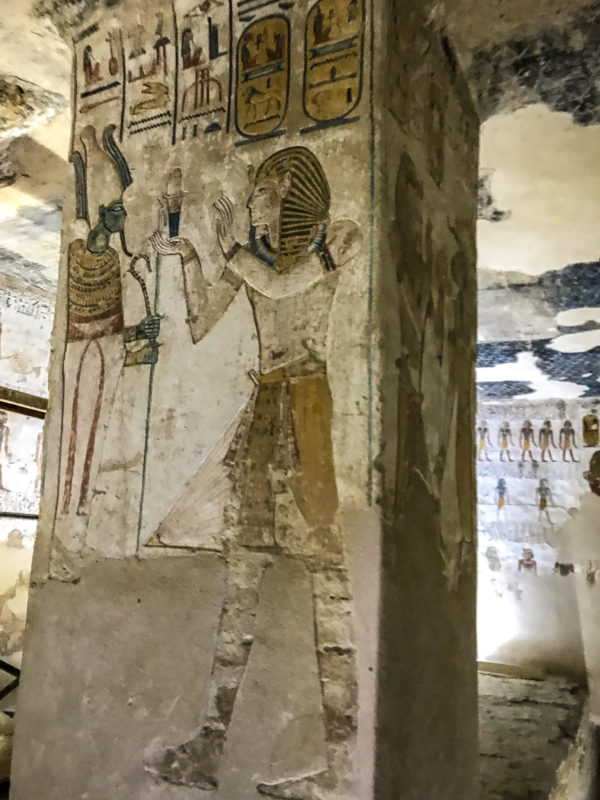
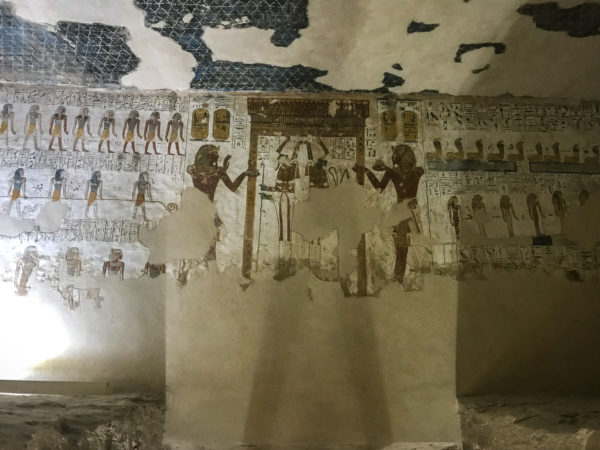
We enjoyed the rest of the day at the pool of our hotel in Luxor.
That was good as Céline didn’t feel very well during the morning.
Visite of Luxor and Karnak temples
The next day in the afternoon, we went to visit Karnak temple, gigantic temple built by several pharaohs including Ramses II and Luxor temple where he is also represented. Apparently his reign was long enough for him to be represented in most temples.
Le lendemain après-midi, nous sommes allés visiter le temple de Karnak, gigantesque temple construit par plusieurs pharaons dont Ramses II ainsi que le temple de Luxor où il est également représenté. Apparemment son règne a été suffisamment long pour qu’il puisse se faire représenter dans la plupart des temples.
Karnak temple
Built and modified for over two millennia, Karnak Temple is the largest religious complex of antiquity.
The visit begins with the model of the temple. We can immediately seize the large scale of the site. Unlike other temples, it’s built on two axes. In addition, many buildings, statues, colonnades and obelisks add up to the temple.

We entered the temple by the Sphinx alley. We continue along several adjacent rooms. The hieroglyphs extend over several floors. The temple has suffered the vagaries of time (earthquakes and others) and is no longer in very good condition. Only a small part of the temple can still be visited.
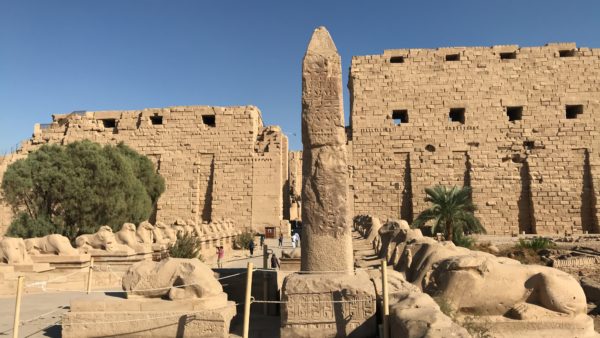
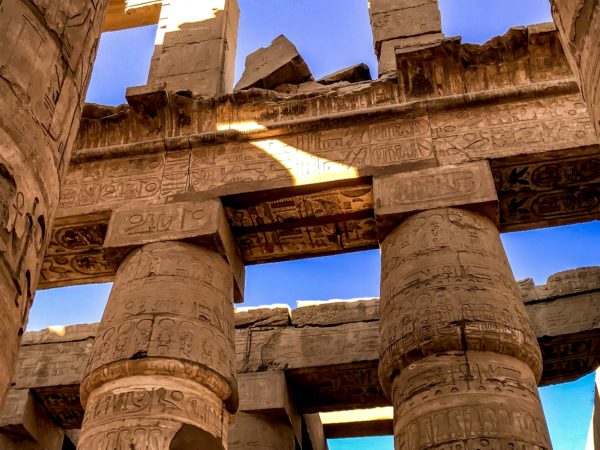

Luxor Temple
The last temple we visited was Luxor at dusk. The cleverly placed lights give a different atmosphere as the one during the day.
The temple is dedicated to the god Amun. We begin the visit with both the obelisk marking the entrance to the site.
But where is the other obelisk? Will you ask me.
I will answer that it’s an excellent question and that the obelisk is in Paris at the Place de la Concorde. The obelisk was traded to France against a clock that is currently in the citadel of Cairo next to the mosque Mohamed Ali. This clock has hardly ever worked and is in permanent repair. If only the Egyptians had known that it was in SWITZERLAND that the best watches were made…
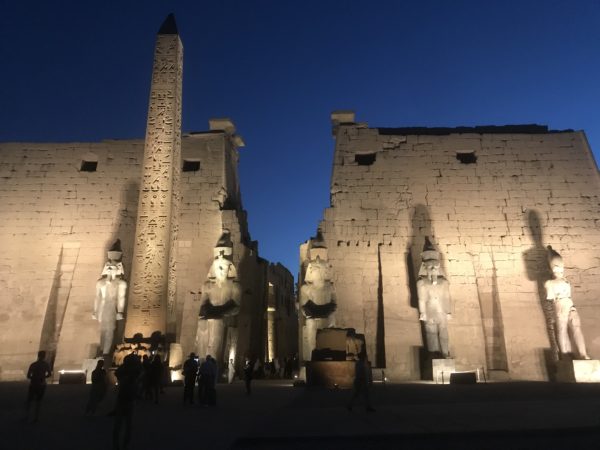
In addition to worshiping the Egyptian gods, there is a mosque and a church in the temple.
The mosque was built over a wall of the temple during the time when the temple was buried in the sand and only the top of the walls was visible.
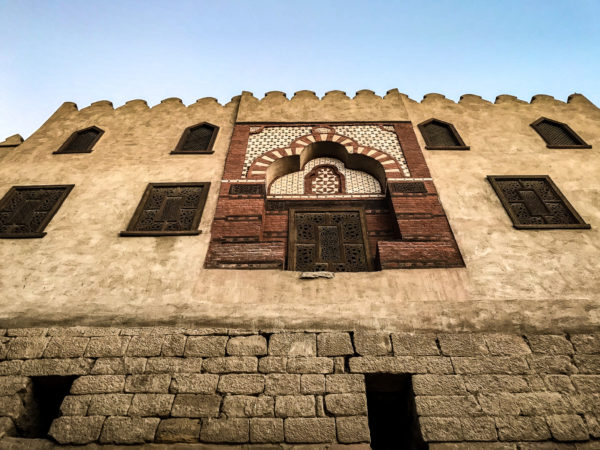
As for the church, it dates from the time of the persecution of Christians by the Romans.
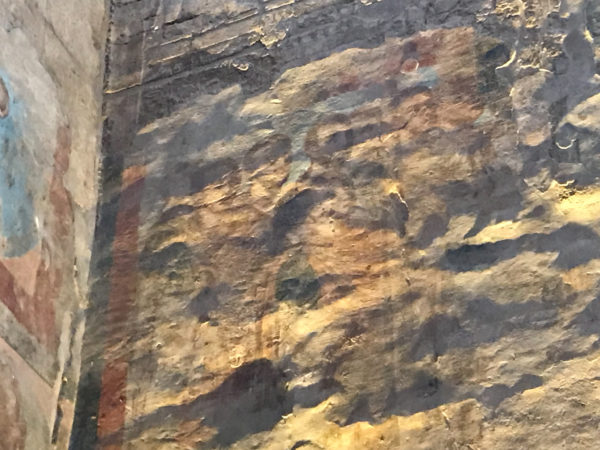
We then arrive on a colonnade alley.
And who else but Ramses II to be represented on the two huge statues in front of the colonnade.
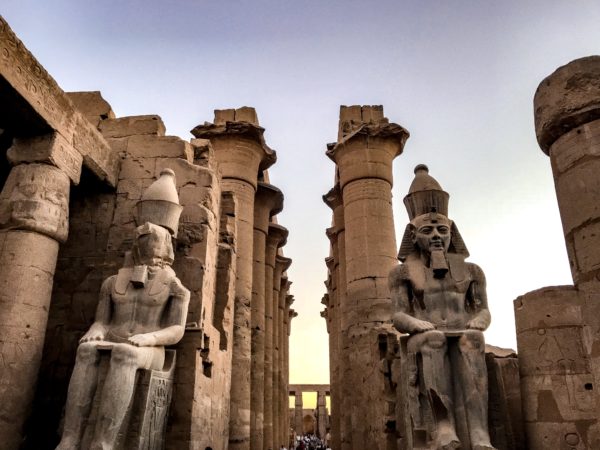
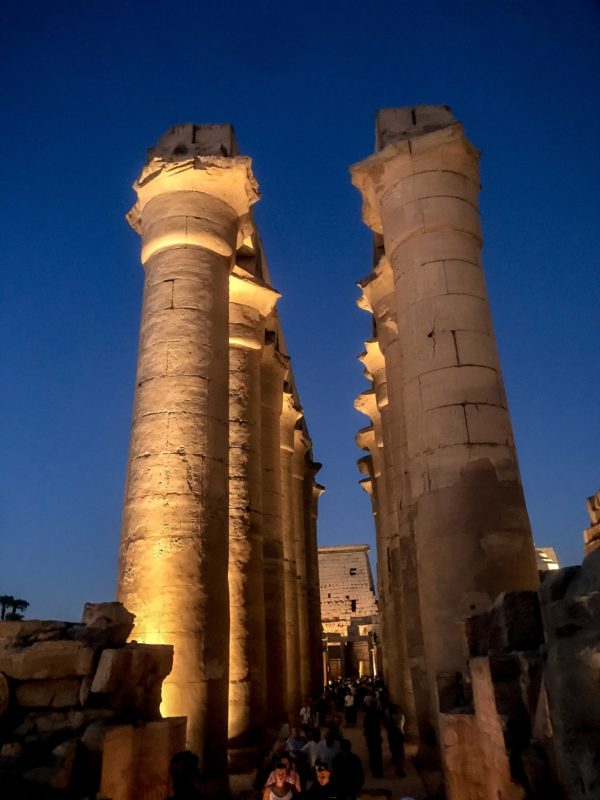
It’s with this magnificent temple that our discovery of ancient Egypt ended.
Relaxation at the Red Sea
After all these visits, we went to rest at the the Red Sea in Hurghada. We stayed three nights, all inclusive at the Sea Star Beau Rivage hotel, a five-star hotel by the sea. We took the opportunity to do an introduction day to scuba diving with Son Bijou diving school.

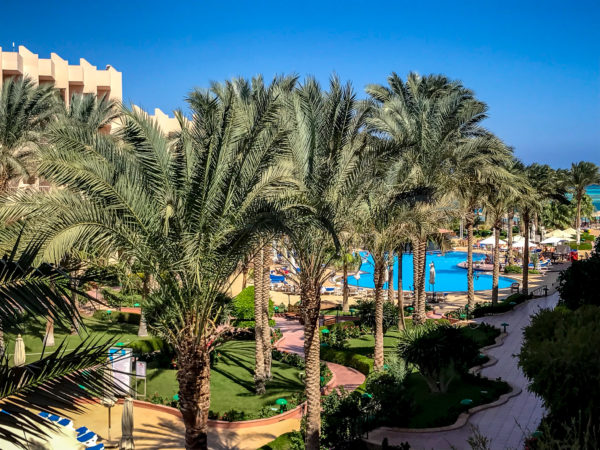
Starting to dive in the Red Sea is a bit like doing your driving school in a Maserati, it makes the Audi of the parents feel like a crap.
Indeed, we dived at a location rightly called Aquarium, which was full of many fish, both in number and type. It was hard to know where to turn our heads as we were surrounded by fish all the time.
It will be hard to beat our first two dives! In addition, you always remember your first time, so…

We did two dives of about 20 minutes, one in the morning and the other in the afternoon. We negotiated the two dives, the trip from our hotel and the food and drinks on the boat for 75 € for both (84 CHF). In my opinion, this is a very good deal as on their website, they offer these dives for 50 € (112 CHF) per person.

Practical advices for a Nile cruise
You will find all our tips on our Nile cruise. To know all our practical advice on Egypt, read our dedicated article.
Which boat did we take for our Nile cruise?
We did the cruise on the boat Semiramis II, a five-star boat. The rooms all had outside facing windows, were quite spacious and clean. We stayed in full board without drinks. The buffet on board was rather average.
The cruise leaves alternately from Aswan or Luxor depending on the day.
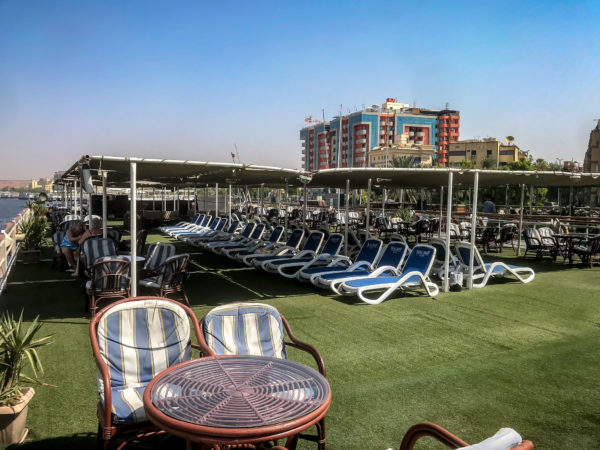

Where did we slept in Luxor?
In Luxor, we stayed on the banks of the Nile at the Lotus Luxor hotel. The view from the lobby and pool is beautiful. Be sure to ask for a room with a view of the Nile to enjoy it from your room as well.
